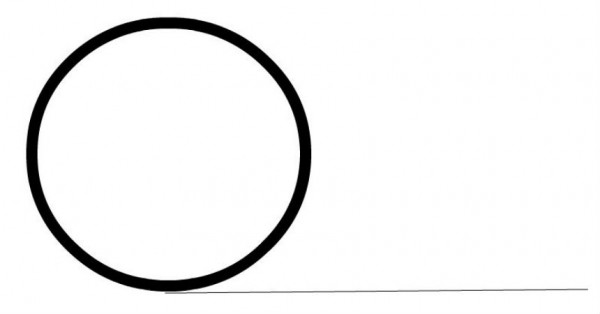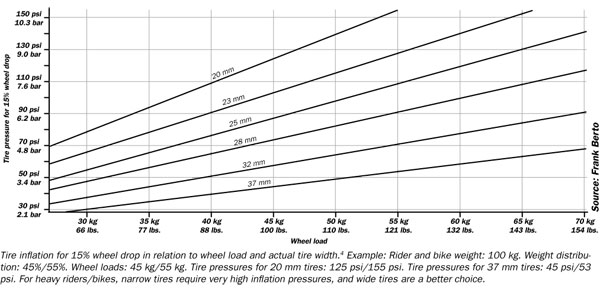Your Bike Tires Are Over-Inflated (Probably)


Efficiency
Under inflated tires are slower. That must mean the more you can inflate the tire, the faster it will be. Right? Not exactly.
If the road surface was perfectly smooth, smoother than glass, then it would be to your advantage to get your tires as stiff as possible to decrease tire resistance. You’d need little more than a strip of of rubber on the wheel.

The reality, of course, is roads aren’t smooth. Not even close. That’s why we have pneumatic tires. Tires are designed to absorb those bumps and imperfections on the road which gives us a more comfortable ride and keeps more momentum going in the direction we want it to go. To understand how this works, let’s look at the extremely un-smooth case.

Let’s assume our intended path of travel is left to right. A few things are about to happen. Newton’s Third Law of Motion tells us there will be right to left force once the wheel hits the next bump. This will decrease your left to right velocity. This next bump will also add some upward motion to the wheel’s path of travel. Both of these these factors cause the wheel to take longer getting from A to B than the wheel on the smooth terrain. The result is bring slower. This is an extreme example but the physics is the same when you scale it down to the road surface variations in the real world.
The beauty of pneumatic tires is they deflect as they come in contact with these small variations in the road allowing the wheel to “float” over them. It’s that deflection that minimizes or eliminates the forces pushing the wheel in additional directions. Unless, your tire is over inflated.
Control and Damage
If the efficiency explanation didn’t convince you to take a fresh look at your tire pressure, consider the control and handling of your bike. An over-inflated tire won’t properly deflect road imperfections resulting in vibration. Ride over a rumble strip on a road and you’ll understand the case for reducing vibration for the sake of comfort alone. But think about what’s happening between the tire and the road. Traction is calculation between the force of the tire against the road and the coefficient of friction between the two. A reduction of the force of the tire against the road will result in less traction. A wheel that is vibrating is just a wheel that is bouncing up and down rapidly. Each time it bounces upward, your traction is reduced.* Reduced traction can lead to all sorts of bad and dangerous situations while on your bike.
The vibration from over-inflated tires also transmits to everything the bike is touching. Your wheels, your hubs, your frame and all the way to your hands and your back. This puts extra wear and tear on everything. Finally, an over-inflated tire is less likely to bend around a sharp object putting you at higher risk for flats.
Optimal Tire Pressure
If you are using the max pressure listed on your sidewall as a guide for your tire pressure, stop. That is just an arbitrary number decided on between the marketing and legal departments of the tire company. It is based on the amount of pressure the tire can hold before it blows off the rim, but that’s not the number they print. They usually give it a safety factor of two. Either way, it has nothing to do with the tire pressure you should be using. Optimal tire pressure is determined by the load it needs to support, the tire width and construction. Road surface and environmental variables can be considered too, especially temperature.**
As a rule of thumb, when you sit on your bike and clip in, you should visibly see a slight bulge in the tires. If not, drop the pressure 5 psi per tire and try again. Repeat until you get the bulge.
Sheldon Brown put together a ton of great detail if you want to see all the math and physics. He also included a chart as a starting point to find the right pressure unique to you and your setup. Bicycle Quarterly did some extensive testing and determined that getting a 15% deflection is the optimal tire pressure to balance performance, comfort, and handling. Higher pressure than that is no faster but less comfortable. 15% deflection is that slight bulge you see when you get on the bike. Keep in mind, this chart is based on wheel load, not your body weight. The weight and weight distribution of your bike needs to be factored in as well. Most road bikes will distribute about 60% of the total weight over your rear wheel. Click on the chart below to download the full report and learn how to measure how the distribution for you on your bike. This chart is also the actual tire width when mounted on your wheel, not what is written on the sidewall. For me, I weigh about 135 lbs plus about 20 lbs for my bike, water, helmet, clothes, etc. That’s about 90 lbs on the rear and 65 lbs on the front. I have 23mm tires so I should use about 90 psi on the back and 65 psi on the front. I used to run 100 psi in the back and 95 in the front. Over the last year, I’ve been experimenting with running lower pressures and arrived at 90 in the back and 85 in the front for most of this summer. Turns out I was spot on for my back wheel but I’m still significantly over-inflated on my front. 65 psi sounds ridiculously low for a road tire, but given how much I’ve noticed improvement in handling, comfort, and speed over the last year, I’m going to try dropping my front tire down a bit more.
*Technically, the moment when the road surface forces the tire up relative to the direction of travel, the force between the tire and the road is increased and therefore traction is increased. It’s the moment after the road stops exerting additional force on the tire that traction is reduced.
**More fun with physics. If you pump up your tires in the morning and go ride for a couple hours, your tire pressure will gradually creep up higher assuming you don’t have a significant slow leak. Volume, pressure, and temperature have an intertwined relationship. Raise the temperature of the gas inside your tire (both from friction of riding and outside temperature changes) and the pressure increases. Volume can change a little too due to rubber stretching but the change in tire pressure is usually measurable.

